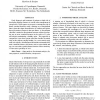Free Online Productivity Tools
i2Speak
i2Symbol
i2OCR
iTex2Img
iWeb2Print
iWeb2Shot
i2Type
iPdf2Split
iPdf2Merge
i2Bopomofo
i2Arabic
i2Style
i2Image
i2PDF
iLatex2Rtf
Sci2ools
87
Voted
ISBI
2008
IEEE
2008
IEEE
Supervised shape analysis for risk assessment in osteoporosis
Early diagnosis and treatment of patients at high risk of developing fragility fractures is crucial in the management of osteoporosis. In this paper we propose to estimate the risk of future vertebral fractures using a training set of longitudinal data to learn the shape characteristics of vertebrae and spines that will sustain a fracture in the near future. A discriminant classifier is trained to discriminate between subjects developing one or more vertebral fractures in the course of 5 years and subjects maintaining a healthy spine. This approach is compared to a one-class system where the classifier is trained only on the subjects staying healthy. In a case-control study with 218 subjects, all unfractured at baseline and matched for main vertebral fracture risk factors such as spine BMD and age, we were able to predict future fractures with a sensitivity of 76% and a specificity of 72%.
Future Fractures | Future Vertebral Fractures | ISBI 2008 | Medical Imaging | Vertebral Fracture Risk |
| Added | 20 Nov 2009 |
| Updated | 20 Nov 2009 |
| Type | Conference |
| Year | 2008 |
| Where | ISBI |
| Authors | Marleen de Bruijne, Paola Pettersen |
Comments (0)

